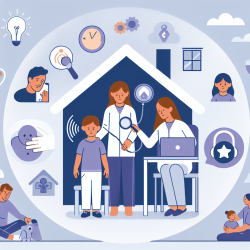Introduction
The integration of robotics in clinical and developmental psychology, particularly in speech-language therapy, offers promising avenues for enhancing therapeutic outcomes for children. The research article "Robotics in Clinical and Developmental Psychology" explores the potential of Socially Assistive Robots (SARs) across various life stages, with a focus on childhood interventions for Autism Spectrum Disorder (ASD) and other conditions. This blog aims to provide insights into how practitioners can leverage these findings to improve their therapeutic practices.
Robotics in Speech-Language Therapy
Speech-language pathologists (SLPs) are continually seeking innovative methods to engage children in therapy. The use of SARs, as highlighted in the research, provides an interactive and engaging platform for children, particularly those with ASD. These robots can mimic social cues and behaviors, making them ideal tools for practicing communication skills in a controlled environment.
Benefits of SARs in Therapy
- Enhanced Engagement: SARs can maintain a child's attention during therapy sessions, which is crucial for effective learning.
- Consistency and Predictability: Robots provide consistent responses, which can be comforting for children with ASD who thrive on routine.
- Data Collection: Robots can track progress and collect data on a child's responses, providing valuable insights for tailoring therapy sessions.
Implementing Robotics in Practice
For practitioners looking to integrate robotics into their therapy sessions, it's essential to start with a clear understanding of the child's needs and the specific goals of therapy. Here are some steps to consider:
- Assessment: Evaluate the child's specific needs and determine how a robot can address these in therapy.
- Customization: Configure the robot to interact in ways that align with the therapy goals, such as practicing turn-taking or improving joint attention.
- Monitoring: Use the robot's data collection capabilities to monitor progress and adjust therapy plans as needed.
Encouraging Further Research
While the current research provides a solid foundation, there is a need for further studies to explore the long-term effects of SARs in speech-language therapy. Practitioners are encouraged to participate in research initiatives and contribute to the growing body of evidence supporting the use of robotics in therapy.
Conclusion
The integration of robotics in speech-language therapy offers a promising avenue for enhancing therapeutic outcomes for children. By leveraging the findings from the research on SARs, practitioners can improve engagement, consistency, and data-driven decision-making in therapy sessions. As the field continues to evolve, ongoing research and collaboration will be key to unlocking the full potential of robotics in clinical settings.
To read the original research paper, please follow this link: Robotics in Clinical and Developmental Psychology.










